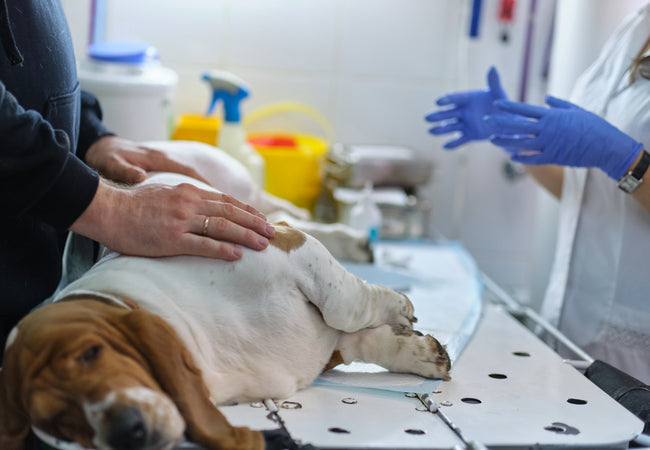Canine Uterine Tumors in 2025 Vet Guide: Diagnosis, Treatment & Prevention 🐶🧬

In this article
Canine Uterine Tumors in 2025 Vet Guide: Diagnosis, Treatment & Prevention 🐶🧬
By Dr. Duncan Houston BVSc
Hello, devoted pet parents! I’m Dr Duncan Houston BVSc. In this 2025 guide, we’ll explore uterine tumors in dogs: rare growths occurring in intact female dogs. We’ll cover types, causes, silent signs, diagnosis, treatment—featuring spay surgery, malignant cases, aftercare, and prevention strategies. Plus, learn how Ask A Vet,support you throughout your pup’s journey 💛.
1. What Are Uterine Tumors?
Uterine tumors in dogs are uncommon—making up just 0.3–0.4 % of all canine tumors. They develop in the uterus's smooth muscle or lining, most often as:
- Leiomyomas: Benign smooth muscle tumors (≈85–90%).
- Leiomyosarcomas: Malignant smooth muscle tumors (≈10%).
- Less frequently: adenomas, adenocarcinomas, fibromas, fibrosarcomas.
2. Who Gets Them?
- Intact female dogs: Spayed dogs are not at risk.
- Middle-aged to older: Most tumors appear in dogs aged ≥ 7–10 years.
- No specific breed risk is established.
3. Silent Conditions & Signs
Most uterine tumors don’t show clinical signs and are discovered incidentally during spay surgery. When symptoms do appear, they can include:
- Abdominal swelling or palpable mass.
- Vaginal discharge or hemorrhage.
- Signs similar to pyometra—drinking/urination changes, lethargy, vomiting.
- Constipation, discomfort due to mass effect.
- Weight loss, inappetence, polyuria/polydipsia.
4. Diagnostic Approach 🔬
- History and physical exam: including abdominal palpation.
- Bloodwork: CBC, biochemistry, urinalysis
- Imaging: X‑rays may reveal uterine enlargement; ultrasound is gold standard.
- Histopathology: Tumor type confirmed after spay via tissue analysis.
- Metastasis screening: Chest X‑rays and abdominal ultrasound for malignant tumors.
5. Treatment Options 🏥
a) Ovariohysterectomy (Spay) – First-Line
This procedure removes both ovaries and uterus—curative for benign tumors and highly recommended even as a diagnostic step. Recovery is straightforward with low risk.
b) Malignant Tumors (Leiomyosarcoma)
When malignant tumors are confirmed:
- Complete surgical excision remains key.
- Chemotherapy (e.g., doxorubicin, carboplatin) may be advised, though its benefit is not well‑defined.
- Radiation therapy is rarely used, given uterine location and unknown response.
c) Supportive Care
- Pain relief, especially post-surgery
- Manage secondary issues—hydration, nausea, bowel support
- Frequent monitoring for pyometra-like complications.
6. Recovery & Prognosis
- Benign leiomyomas: Excellent prognosis—spay is curative.
- Leiomyosarcomas: Guarded prognosis—dogs do well if tumors are localized and fully removed; metastasis lowers survival.
- Follow-up: Physical exams every 3–6 months, with imaging for malignant cases.
7. How Ask A Vet🛠️
- Ask A Vet: 24/7 advice on post-op home care, monitoring for complications, medication reminders, and when to seek emergency care.
8. Prevention & Health Tips 🛡️
- Early spaying: Spay before first heat—prevents uterine tumors, pyometra, and mammary cancers.
- Regular reproductive exams if your dog remains intact.
- Watch for discharge or abdominal changes, and consult your vet promptly.
9. Emotional Support for You & Your Dog ❤️
Even incidental findings can feel overwhelming. Ask A Vet offers emotional reassurance during care decisions.offer comfort aids and recovery tools to ease your journey. You’re never alone—online communities, veterinary care teams, and fellow pet parents are here to support you.
10. Final Thoughts
Canine uterine tumors are rare—and benign in most cases. Routine spay surgery is both preventative and curative. Malignant tumors require additional treatment and monitoring. With timely detection, expert veterinary care, and support from Ask A Vet, your dog has the best chance at a full, comfortable life 🐾.
— Dr Duncan Houston BVSc
For ongoing care help, visit AskAVet.com and download the Ask A Vet app today!






